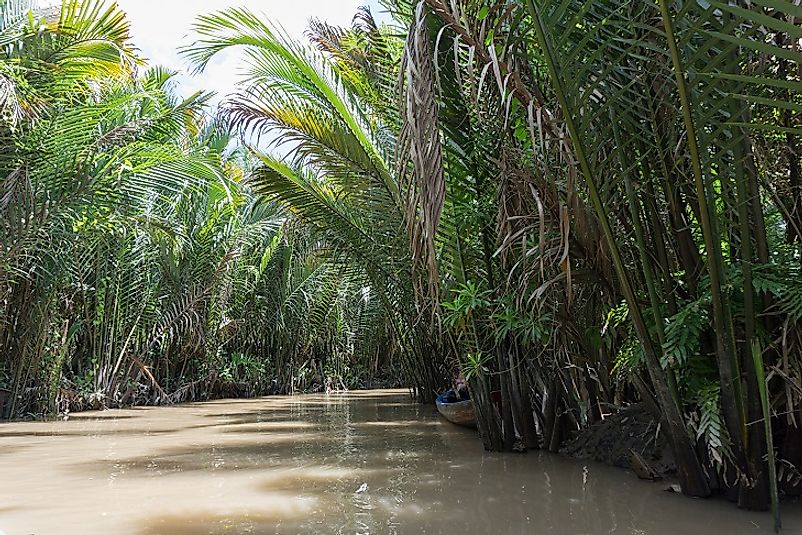Ecological Regions Of Vietnam

Vietnam is one of the Indochinese Peninsular countries in Southeast Asia. The country is the 14th most populous country in the world, and borders China, Laos, Cambodia, and Malaysia. Vietnam location is between latitude 8 and 24 degrees North and longitude 102 and 110 degrees east. The country covers an area of 331,210 square kilometers with a coastline of 3,444 kilometers long. It is characterized by Highlands on the northern part. The highest elevation is 3143 meters above the sea level. Vietnam has two world national heritage Ha Long Baya and Phong Nha-Ke Bang National Park. The country possesses unique biodiversity and is ranked 16th in the world in biodiversity. The country is divided into six ecological regions, including those looked at below.
Annamite Range Moist Forests
The Annamite Range Moist Forests lie in Laos and extend into the Annamite Range in Vietnam. The area is characterized by limestone karst topography. The climatic condition in this region changes abruptly throughout the year, especially along the mountain crest. The area receives an annual rainfall of between 1,500 millimeters and 2,500 millimeters. The higher elevation areas of this ecological region experience cooler temperatures throughout the seasons. There are various species of animals inhabiting Annamite Range Moist Forests region. These species are either endemic or near-endemic species. The region faces several threats including human activities such as land clearing for cultivation and poaching. The threats are not as significant as other regions.
Northern Indochina Subtropical Moist Forests
This ecological region is dominated by evergreen and semi-evergreen forests. The evergreen trees form the largest number of plant species of the terrestrial ecosystem. The forest canopy is divided into multiple layers, including the overstory, medium layer, lower canopy, and shrub canopy. The forest is home to some wildlife including monkeys, apes, snakes and wild cat. Human activities have led to the destruction of over 100 species of animals. These threats include burning of vegetation and deforestation. Due to deforestation, 17,000 species of trees and plants are destroyed every year. The government of Vietnam has put in measures aimed at reducing the destruction of the biodiversity in this ecological region.
Southeast China-Hainan Moist Forests
The Southeast China-Hainan Moist Forests have a moist monsoon tropical climate that brings rain through the movement of humid equatorial air masses. The region receives an average annual rainfall of around 2,000 millimeters, and typhoons also occasionally strike the area. Southeast China-Hainan Moist Forests has a high biodiversity comprising of 4200 plant species, 98 species of mammals and 291 species of birds. Conifer species dominate the interior upland, and the species include taxa, Podocarpus imbricate and Dacrydium. The animal species include Hainan flying squirrel, moonrat, thin, black gibbon, Asiatic black bear, and Hainan Mole. The biodiversity in the country faces severe threats from deforestation and destruction of the habitats. The forest cover has reduced by 25% in the last 50 years. All the bids species within this ecological region are threatened while the mammal species face extinction due to excess poaching and destruction of their habitats. The area is under the protection of the government of Vietnam due to these threats.
Other Ecoregions of Vietnam
Other ecological regions in Vietnam include the Central Indochina Dry Forests, the Mekong River System, and the Xi Jiang River System. The biomes housing the ecological regions of Vietnam include freshwater rivers and Tropical and Subtropical Dry Broadleaf Forests. Each of these ecological regions face threats due to human activities such as deforestation, poaching, and land clearing.
Ecological Regions Of Vietnam
| Ecoregion | Terrestrial Biome or Type (if Non-Terrestrial) |
|---|---|
| Annamite Range Moist Forests | Tropical and Subtropical Moist Broadleaf Forests |
| Northern Indochina Subtropical Moist Forests | Tropical and Subtropical Moist Broadleaf Forests |
| Southeast China-Hainan Moist Forests | Tropical and Subtropical Moist Broadleaf Forests |
| Central Indochina Dry Forests | Tropical and Subtropical Dry Broadleaf Forests |
| Mekong River System | Freshwater |
| Xi Jiang River System | Freshwater |











